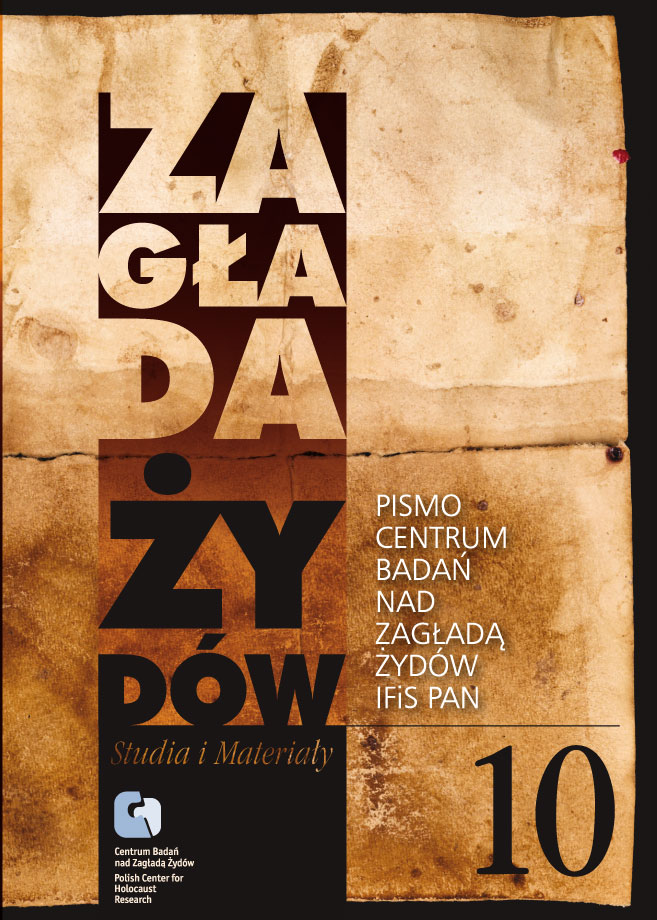Krzesiny i Kreising – między pamiętaniem a pomijaniem. Polskie miasteczko wobec historii, pamięci i rywalizacji w cierpieniu
Zagłada Żydów. Studia i Materiały, Nr 10 (2014), Strony: 443-461
Data zgłoszenia: 2020-10-22Data publikacji: 2014-12-01
 https://doi.org/10.32927/ZZSiM.532
https://doi.org/10.32927/ZZSiM.532
Abstrakt
The area around Krzesiny, located near the city of Poznań, Poland, witnessed several dark events during World War II: Germans oppressed the local population, culminating in a terrorizing action dubbed “akcja krzesińska;” also, a forced labor camp, named “Kreising,” was built near the township, housing mainly Jews. After the war, the suffering in Krzesiny was remembered, but selectively – “akcja” and other forms of Polish suffering were commemorated, while the camp was not. By exploring the “lieux de mémoire” in Krzesiny – dynamics of memory in a small township in Poland – this paper uses localized research to address the issue of gaps in collective memory and commemoration. We briefly look at the relevant history, Polish memory regarding wartime events in Krzesiny, and the postwar dynamics of collective memory. Discussing the latter, we identify a new phenomenon at work, one which we dub “collective disregard” – group neglect of the past of the “Other” that occurs without clear intent. We argue that “collective disregard” is an issue that naturally occurs in the dynamics of memory. By making a deliberate investment in balanced remembrance and commemoration, societies can counter the tendencies of “disregard” and curb the controversies of competitive victimization claims, also called “competitive martyrdom”.
Licencja
Prawa autorskie (c) 2014 Autor & "Zagłada Żydów. Studia i Materiały"

Utwór dostępny jest na licencji Creative Commons Uznanie autorstwa 4.0 Międzynarodowe.
https://creativecommons.org/licenses/by/4.0
Podobne artykuły
- Stephan Lehnstaedt, Akcja „Reinhardt” w świetle najnowszej niemieckiej literatury przedmiotu , Zagłada Żydów. Studia i Materiały: Nr 13 (2017)
- Zofia Wóycicka, W poszukiwaniu nowych sposobów na wyrażenie tego, co trudne do pojęcia. Muzea i miejsca pamięci poświęcone Zagładzie w XXI w. , Zagłada Żydów. Studia i Materiały: Nr 20 (2024)
- Zofia Wóycicka, Muzeum dla dorosłych. Nowa wystawa w Miejscu Pamięci Cichych Bohaterów w Berlinie , Zagłada Żydów. Studia i Materiały: Nr 18 (2022)
- Jacek Leociak, Redakcja Czasopisma, Dyskurs o pomocy , Zagłada Żydów. Studia i Materiały: Nr 4 (2008)
- Roma Sendyka, „Zbadane, ujawnione i wyjaśnione”: o metodzie śledczej w badaniach fotografii Holokaustu: Wendy Lower, The Ravine: A Family, a Photograph, a Holocaust Massacre Revealed [Roma Sendyka] , Zagłada Żydów. Studia i Materiały: Nr 17 (2021)
- Tomasz Frydel, Zwykła organizacja, nadzwyczajna przemoc państwowa. Polska policja granatowa a Zagłada we wschodniej części dystryktu krakowskiego , Zagłada Żydów. Studia i Materiały: Nr 17 (2021)
- Katarzna Stec, Jolanta Ambrosewicz-Jacobs, Islands of Memory. The Landscape of the (Non)Memory of the Holocaust in Polish Education from 1989 to 2015 [Katarzyna Stec] , Zagłada Żydów. Studia i Materiały: Nr 17 (2021)
- Adam Kopciowski, Pinkes Warsze – Kronika Warszawy , Zagłada Żydów. Studia i Materiały: Nr 10 (2014)
- Piotr Filipkowski, Piotr M.A. Cywiński, Auschwitz. Monografia Człowieka [Piotr Filipkowski] , Zagłada Żydów. Studia i Materiały: Nr 17 (2021)
- Heléna Huhák, András Szécsényi, Kawalkada interpretacji. Pociąg Kastnera w osobistych narracjach uciekinierów , Zagłada Żydów. Studia i Materiały: Nr 18 (2022)
<< < 1 2 3 4 5 6 7 8 9 10 11 12 13 14 15 16 17 18 19 20 21 22 23 24 25 26 27 28 29 30 31 32 > >>
Możesz również Rozpocznij zaawansowane wyszukiwanie podobieństw dla tego artykułu.
 English
English
 Język Polski
Język Polski








